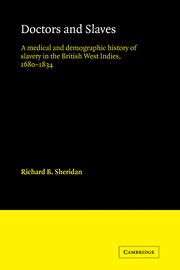 Doctors and Slaves
Doctors and Slaves Book contents
- Frontmatter
- Contents
- List of tables and figures
- Preface
- Acknowledgment
- 1 The disease environments and epidemiology
- 2 The medical profession
- 3 African and Afro-West Indian medicine
- 4 The Guinea surgeons
- 5 Slaves and plantations
- 6 Labor, diet, and punishment
- 7 Morbidity and mortality
- 8 The problem of reproduction
- 9 Smallpox and slavery
- 10 Slave hospitals
- 11 Plantation medical practice
- 12 Slavery and medicine
- Notes
- Bibliography
- Index
1 - The disease environments and epidemiology
Published online by Cambridge University Press: 04 August 2010
- Frontmatter
- Contents
- List of tables and figures
- Preface
- Acknowledgment
- 1 The disease environments and epidemiology
- 2 The medical profession
- 3 African and Afro-West Indian medicine
- 4 The Guinea surgeons
- 5 Slaves and plantations
- 6 Labor, diet, and punishment
- 7 Morbidity and mortality
- 8 The problem of reproduction
- 9 Smallpox and slavery
- 10 Slave hospitals
- 11 Plantation medical practice
- 12 Slavery and medicine
- Notes
- Bibliography
- Index
Summary
He [the adventurous physician] establishes for his guide some fanciful theory…of mechanical powers, of chemical agency, of stimuli, or irritability… or some other ingenious dream, which lets him into all nature's secrets at short hand. On the principle which he thus assumes, he forms his table of nosology…and extends his curative treatment… I have lived myself to see the disciples of Hoffman, Boerhaave, Stahl, Cullen, and Brown succeed one another like the shifting figures of a magic lantern…The patient, treated on the fashionable theory, sometimes gets well in spite of the medicine.
Thomas Jefferson, 1807This introductory chapter surveys the sources of our knowledge of population in the West Indies; die physical, social, and disease environments of the region; and interactions with other disease environments. Accordingly, we investigate the rise of the South Atlantic System with special reference to the spread of infectious disease through the movement of people and their microorganisms, the expansion of slave-grown sugar and other agricultural staples, the killer diseases of malaria and yellow fever, and the findings of the Army Medical Board's Report. Later sections of the chapter focus on medical writings that sought to advance rational conceptual schemes of disease causation, prevention, control, or eradication. Major emphasis is placed on the nature and incidence of slave diseases and injuries.
- Type
- Chapter
- Information
- Doctors and SlavesA Medical and Demographic History of Slavery in the British West Indies, 1680–1834, pp. 1 - 41Publisher: Cambridge University PressPrint publication year: 1985


